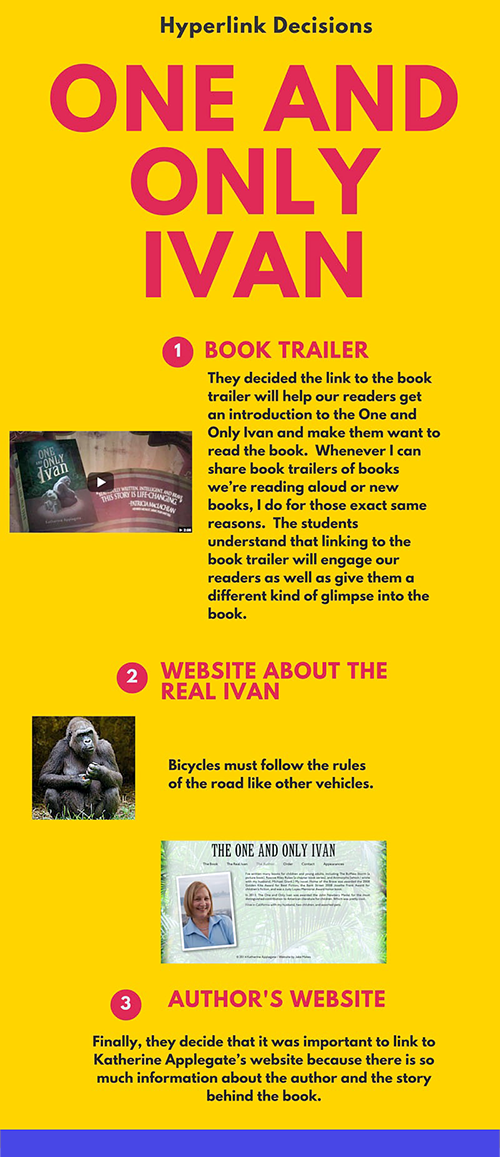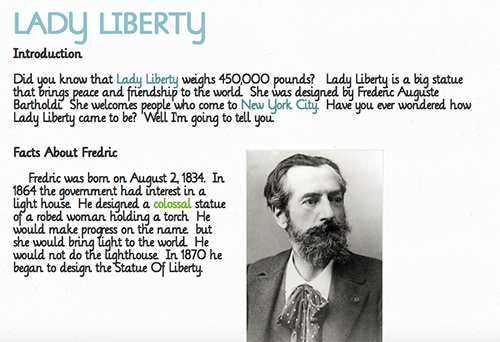Chapter 5: Making Purposeful Decisions as Digital Writers
5.3 Digging Deeper with Text
Typeface
It took me a long time to figure out that I had to explicitly teach students some minimal information about typeface. Sure, they knew about bold letters for headings, but they still spent much of their time clicking on different fonts to see which ones looked the “coolest.” A few simple lessons on how the typeface can impact the author’s message help students get started with their own compositions.
It’s important that the reader can read what’s been written. Some script fonts are hard to read when there is a long body of text. Williams says, “Scripts are like cheesecake – they should be used sparingly so nobody gets sick.” (pg. 181) Fonts with rounded edges give a friendlier message as opposed to those with geometric edges, which are solid and strong.
Hypertext
Students know that when they click on a live link, they will be taken to another place on the Internet, be it another website, an image, or a definition. With close study of mentors, students begin to see the relationships between one of piece of information that is linked to another.
We begin by looking closely at several different websites. I ask students to specifically click on the links to see where they lead the reader. They keep track of their findings and then we gather to share. As students share, we can then begin to categorize how the linked texts are connected. Wonderopolis®, DogoNews, National Geographic for Kids and KidsHealth use hyperlinks in similar ways. In all four, the links can lead to:
- related articles within their site,
- other websites about similar topics,
- or to definitions of content vocabulary.
In the case of National Geographic for Kids, some links will also lead to their store where consumers can buy books or other items. KidsHealth also links to related videos as well as biographies of the authors.
After gathering this information, we have more questions:
- How does the author decide which words to link?
- How does the author know what information to add to those links?
- How does the author decide which words need definitions?
- Does the writer add links to an outside source or to material he’s created and saved elsewhere on his website?
- How does the author ensure that the links add to the text and not detract from it?
I teach this lesson relatively early in the year through a shared writing experience with my students so that we can discuss the decisions writers make. Adding hyperlinks basically follows the same procedure regardless of the platform being used. Once students understand the why and how, they are able to transfer that knowledge to all of their digital writing.
Since we had just finished our read aloud, we decided to write a book review of Katherine Applegate’s The One and Only Ivan for our class blog. We begin by thinking about our audience and purpose. We know that family members read our blog as do some other classrooms we’ve connected with outside of our school. We know that we want our audience to know more about The One and Only Ivan because we love it so much. We hope that they will want to read the book and have a conversation with us through the comments section.
We began by discussing what was important and what we wanted our audience to know about the book and author. We also referred to other blogs we’d read about books and came to a consensus. We would add hyperlinks to three things for the following reasons:

Our text:
We decide that there aren’t any words we want to define, so we’ll limit our hyperlinks to those three sites. Remember, we don’t want to overload our readers with outside sites. We also decide that the addition of these sites will add to our reader’s understanding of the One and Only Ivan and won’t detract from our original intention of inspiring them to read the book. Next, we have to decide which words to add links to. As a group we decide to link the book trailer to the book title; Katherine Applegate’s website to her name, the real Ivan’s story to Ivan’s name (noted in bold print above).
